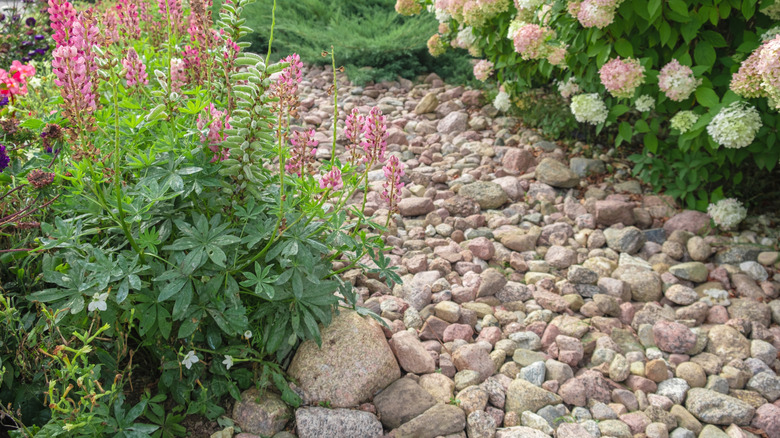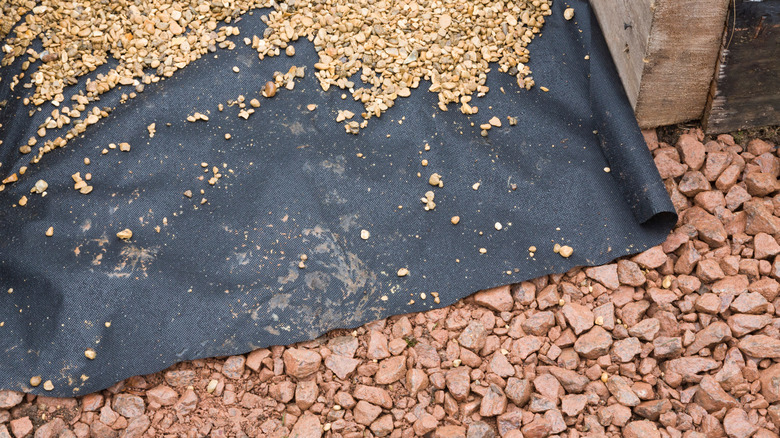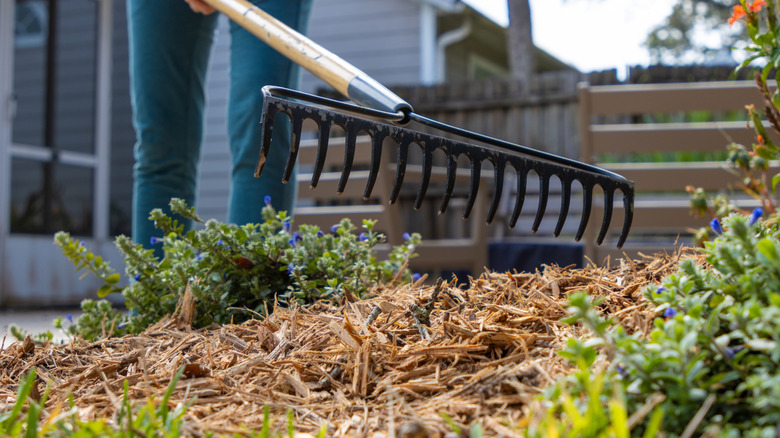The Biggest Mistake When Switching From Gravel To Mulch (And How To Do It Correctly)
We may receive a commission on purchases made from links.
Are you looking for a way to enhance the look of your flower beds? Changing up the positioning of your plants or even the varieties of flowers in your garden might be one of the first upgrades that come to mind. These changes can certainly help with the aesthetics of your flower beds, but changing your landscaping material from gravel to mulch can also improve not only the appearance, but health of your garden. However, when switching from gravel to mulch, it's important to complete the process correctly to avoid some of the most common mistakes when working with gravel. The mistakes people often make with this type of DIY landscaping project include not removing the gravel properly and not adequately preparing for the project in terms of verifying drainage.
Before diving into a gravel removal project, you should look at the benefits and drawbacks of both gravel and mulch to make sure you choose the one that's best for your flower beds. Gravel is an excellent choice for gardens focusing on drainage, while mulch is great for giving plants nutrients and a robust environment. However, there are downfalls with gravel, such as rocks settling into the soil and affecting plant growth. With mulch, there's often added maintenance compared to gravel, as the material needs to be replaced more often than rocks. Be sure to look at your garden's specific qualities to determine which will help your flowers thrive.
The biggest mistakes to avoid when switching from gravel to mulch
While switching from gravel to mulch as a landscaping material is often labor-intensive, it's generally a beginner-friendly project. Still, there are some common mistakes people tend to run into, starting with not properly preparing for the upgrade in terms of research and planning. For example, you should look into the current drainage solution, if any, for your property and make a plan to replace that if it's dependent on the gravel.
Many gravel gardens have a French drainage system, which is essentially a trench under the rocks that holds a drainage pipe. This pipe takes excess water and directs it away from the garden. Gravel is one of the best choices to top a French drain, as it allows for water to pass through the rocks. You can use mulch with these systems, but you'll need to lay down a barrier fabric to prevent it from clogging the system. Without this additional step, you risk water backing up onto the property or even in your basement.
Another common mistake that's often made when removing gravel from a flower bed is not taking the time to make sure all of the material is gone. It's not uncommon for gravel to shift over time and work its way deeper into the soil if there's no weed barrier. This setting can make the rocks challenging to remove if you only do a few passes over the area or use the wrong tools.
Helpful tips for switching from gravel to mulch for your garden
If you're ready to switch from landscaping gravel to mulch for your flower beds, there are some helpful tips to complete this process correctly. You'll want to start by using a shovel or rake to break up the gravel and make it easier to remove. For thin layers of gravel, you can use these tools to take out most of the rocks. However, large areas or gardens with several layers of rock may need machinery like a backhoe to do the heavy lifting. If you notice a lot of small pebbles left behind in the soil, you may need to use a sifter like the Achla Designs Compost Sifter Screen with Handles to get these out. Use the rake to comb through the soil and make sure it's clear of any leftover debris.
Next, it's time to lay landscaping fabric, if desired, to help prevent weeds from taking over the flower beds. Grab your mulch bags and start by laying an even layer of the material in the bed. You can use your hands or a rake to spread the mulch through the area. The final product should be around two inches thick. Be sure not to make the mistake of using too much mulch, as this can be harmful to plant health. Looking for a way to make your mulch stand out from generic color options? Consider DIY-dying your mulch for a one-of-a-kind curb appeal!


